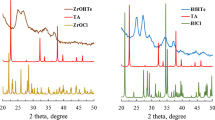Abstract
The effect of K addition on the amount and dispersion of carbon deposition on metal sites and support sites was investigated on a physical mixture for hexane dehydrogenation. TPO, BET and ESR experiments were used for characterization. The K addition significantly decreases catalyst deactivation involving the amount of coke deposits and the density of carbon radicals on the metal and support sites because of ensemble and electronic effects, especially on the metal sites. Coke on the metal sites associated with carbonaceous species rich in hydrogen is less polymerized than coke on the support sites, corresponding to a more graphitic-like carbon.
Similar content being viewed by others
References
Afonso, J. C., Schmal, M. and Frety, R., “The Chemistry of Coke Deposits Formed on a Pt-Sn Catalyst during Dehydrogenation of n-Alkanes to Mono-olefins,”Fuel Pro. Tech.,41, 13 (1994).
Barbier, J., “Coking of Reforming Catalysts,”Catalyst Deactivation, 1 (1987).
Beltramini, J. and Trimm, D. L., “Activity, Selectivity and Coking over Mono-and Bi-metallic Reforming Catalysts,”Appl. Catal.,32, 71 (1987).
Biswas, J., Bickle, G. M., Gray, P.G., Do, D.D. and Barbier, J., “The Role of Deposited Poisons and Crystallite Surface Structure in the Activity and Selectivity of Reforming Catalysts,”Catal. Rev.-Sci. Eng.,30(2), 161 (1988).
Biswas, J., Gray, P.G. and Do, D. D., “The Reformer Lineout Phenomenon and its Fundamental Importance to Catalyst Deactivation,”Appl. Catal.,32, 249 (1987).
Bond, G. C., “Heterogeneous Catalysis: Principles and Application,” Clarendon Press, Oxford (1987).
Butt, J. B. and Peterson, E. E., “Activation Deactivation and Poisoning of Catalysts,” Academic Press Inc. (1988).
Cortright, R. D. and Dumesic, J. A., “Effects of Potassium on Silicasupported Pt and Pt/Sn Catalysts for Isobutane Dehydrogenation,”J. Catal.,157, 576 (1995).
Guisnet, M. and Magnoux, P., “Coking and Deactivation of Zeolites: Influence of the Pore Structure,”Appl. Catal.,54, 1 (1989).
Gutsze, A., Roland, U. and Karge, H. G., “Evidence for a Charge Transfer from Spilt-over Hydrogen to Platinum by Means of ESR Spectroscopy,”Spillover and Migration of Surface Species on Catalysts, 417 (1997).
Hill, J.M., Cortright, R.D. and Dumesic, J. A., “Silica- and L-zeolitesupported Pt, Pt/Sn and Pt/Sn/K Catalysts for Isobutane Dehydrogenation,”Appl. Catal.,168, 9 (1998).
Inaba, M., Kintaichi, Y., Hamada, H., “Cooperative Effect of Platinum and Alumina for the Selective Reduction of Nitrogen Monoxide with Propane,”Catal. Lett.,36, 223 (1996).
Jovanovic, M. R. and Putanov, P. S., “Nature and Distribution of Coke Formed on Mono-metallic Platinum and Bimetallic Platinum-rhenium Catalysts,”Appl. Catal.,159, 1 (1997).
Kirszensztejn, P., Foltynowicz, Z. and Wachowski, L., “Peculiar Pore Structure of the Coke Coating Formed on Pt-Sn/γ-Al2O3 Catalysts,”Ind. Eng. Chem. Res.,30, 2276 (1991).
Lange, J. P. and Gutsze, A., “Coke Formation through the Reaction of Ethene over Hydrogen Mordenite: III. IR and 13C-NMR Studies,”Appl. Catal.,45, 345 (1988).
Lange, J. P., Gutsze, A. and Karge, H. G., “Coke Formation through the Reaction of Olefins over Hydrogen Mordenite: I. EPR Measurements under Static Conditions,”J. Catal.,114, 136 (1988).
Lange, J. P., Gutsze, A. and Karge, H. G., “Coke Formation through the Reaction of Olefins over Hydrogen Mordenite: II. Insitu EPR Measurements under on-Stream Conditions,”J. Catal.,114, 144 (1988).
Larsson, M., Hulten, M., Blekkan, E. A. and Andersson, B., “The Effect of Reaction Conditions and Time on Stream on the Coke Formed during Propane Dehydrogenation,”J. Catal.,164, 44 (1996).
Lietz, G. and Volter, J., “Initial Changes of the Catalytic Properties of Platinum Containing Catalysts: I. Transformations of Mono- and Bimetallic Pt/Al2O3 Catalysts by Carbonaceous Deposits,”Appl. Catal.,13, 77 (1984).
Liwu, L., Tao, Z., Jingling, Z. and Zhusheng, X., “Dynamic Process of Carbon Deposition on Pt and Pt-Sn Catalysts for Alkane Dehydrogenation,”Appl. Catal.,67, 11 (1990).
Lunsford, J. H., “Electron Spin Resonance in Catalysis,”Advances in Catalysis,22, 265 (1972).
Macleod, N., Fryer, J. R., Stirling, D. and Webb, G., “Catal. Deactivation of Bi- and Multimetall Reforming Catalysts: Influence of Alloy Formation on Catalyst Activity,”Catal. Today,46, 37 (1998).
Mann, R., “Catalyst Deactivation by Coke Deposition: Approaches Based on Interactions of Coke Laydown with Pore Structure,”Catal. Today,37, 331 (1997).
Padro, C. L., de Miguel, S. R., Castro, A.A. and Scelza, O.A., “Stability and Regeneration of Supported PtSn Catalysts for Propane Dehydrogenation,”Catalyst Deactivation, 191 (1997).
Rostrup-Nielsen, J. R., “Industrial Relevance of Coking,”Catal. Today,37, 225 (1997).
Shum, V.K., Butt, J. B. and Sachtler, W. M. H., “The Dehydrocyclization-Controlling Site in Bifunctional Reforming Catalysts,”Appl. Catal.,11, 151 (1984).
Tao, Z., Jingling, Z. and Liwu, L., “Relation between Surface Structure and Carbon Deposition on Pt/Al2O3 and Pt-Sn/Al2O3 Catalysts,”Catalyst Deactivation, 143 (1991).
Trimm, D. L., “Catalyst Design for Reduced Coking,”Appl. Catal.,5, 263 (1983).
Trimm, D. L., “Catalysts for the Control of Coking during Steam Reforming,”Catal. Today,49, 3 (1999).
Werlz, J. E. and Bolton, J. R., “Electron Spin Resonance: Elementary Theory and Practical Applications,” Chapman and Hall Ltd., New York (1972).
Author information
Authors and Affiliations
Corresponding author
Rights and permissions
About this article
Cite this article
Srihiranpullop, S., Praserthdam, P. & Mongkhonsi, T. Deactivation of the metal and acidic functions for Pt, Pt-Sn and Pt-Sn-K using physically mixed catalysts. Korean J. Chem. Eng. 17, 548–552 (2000). https://doi.org/10.1007/BF02707164
Received:
Accepted:
Issue Date:
DOI: https://doi.org/10.1007/BF02707164




